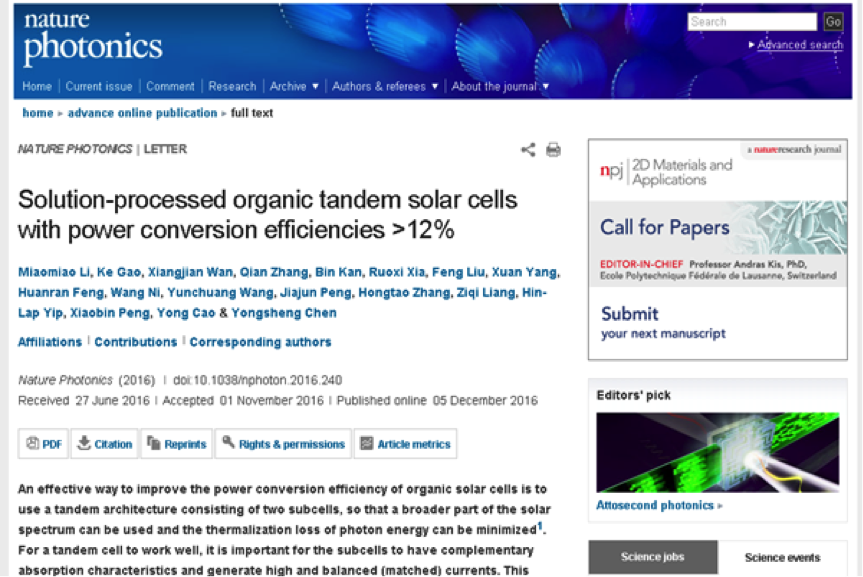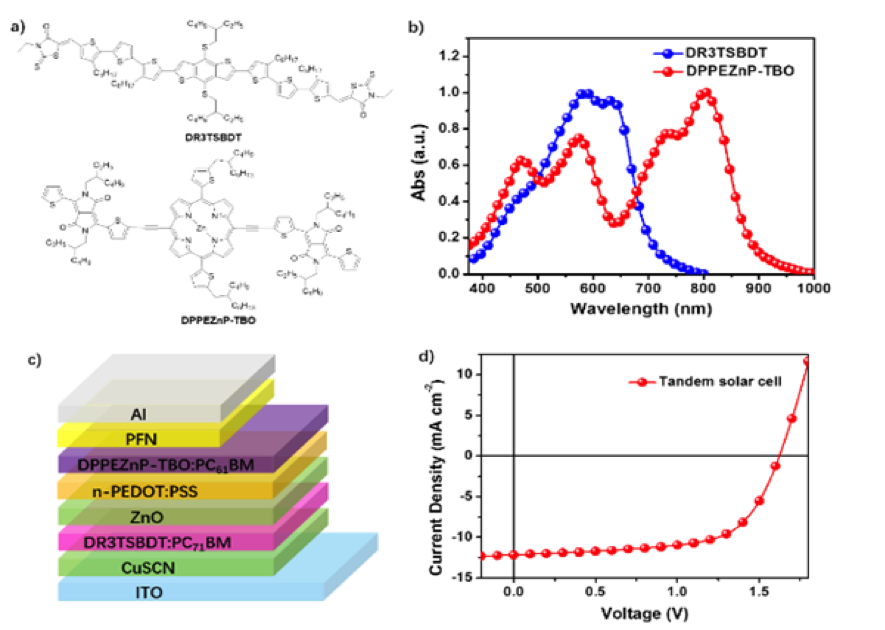Nankai University’s Research on Organic Solar Cells made a Breakthrough Power Conversion Efficiencies reached up to 12.7%
2016.12.17

Professor Chen Yongsheng from Nankai University’s College of Chemistry and his team made a breakthrough in the research on organic solar cells. They took advantage of oligomer’s complementary absorption and built electron donor materials in the front and rear subcells, achieving a power conversion efficiency of 12.50% (verified 12.70%). It is the highest PCE of all the solution-processed organic photovoltaic devices reported in the literature so far.
The results of the research were published in the international journal Nature Photonics on December 5th.
Organic solar cells (OSCs) have received an extensive amount of attention for renewable energy sources because of advantageous features such as low cost, flexibility, light weight and solution-based fabrication.
However, since the first organic solar cell device was invented in 1958, how to improve the power conversion efficiencies has become a key problem for the scientists. The researchers want to find out whether organic solar cells can be promoted out of the laboratory and be widely applied to people’s living and producing style.
Prof. Chen Yongsheng said, “Recently, as a result of extensive studies and a deeper understanding of OSC mechanisms, new active layer material design and device optimization, OSC performance has improved dramatically.”

a) Molecular structures of DR3TSBDT and DPPEZnP-TBO. b) Normalized absorption spectra of DR3TSBDT and DPPEZnP-TBO films. c) Device architecture of the tandem solar cell. d) J–V curve and EQE curve
For years, Prof. Chen Yongsheng’ team has carried forward deep and systematic research on organic photovoltaic device materials and construction techniques, developing a series of high-efficient solution-treated oligomer molecule active layer materials. In 2015, they achieved power conversion efficiencies (PCEs) of 10–11% for single-junction cells.
Considering the requirements of production, they took the application of the subcell donor as an effective strategy. Thus they have reported tandem cells as the rear and front subcell donors and prepared the organic photovoltaic device with PCEs of over 10%. (Adv. Mater., 2016, 28, 7008–7012.
Recently, Prof. Chen Yongsheng’s team cooperated with a team from the South China University of Technology and with other teams. They reported a high-performance solution-processed, tandem solar cell based on the small molecules DR3TSBDT and DPPEZnP-TBO, which offer efficient, complementary absorption when used as electron donor materials in the front and rear subcells, respectively. Optimized devices achieve a power conversion efficiency of 12.50% (verified 12.70%), which represents a new level of capability for solution-processed, organic solar cells. (Nature Photon., 2016, published online.)
The researchers introduced that, according to the design mechanism, thanks to the further optimization of the materials and devices, the index of devices, as well as power conversion efficiencies, have a large potential for improvement. It is predicted that in the near future, the power conversion efficiencies may reach up to more than 15%.
Prof. Chen Yongsheng said, “The next step is going to focus on the cells life and improve the power conversion efficiencies. I believe the dream of putting organic solar cells into practical application and commercial production will come true in the near future.”
The research is financially supported by MoST, NSFC and the International Science, and Technology Cooperation Program of China.
Link to the paper: http://www.nature.com/nphoton/journal/vaop/ncurrent/full/nphoton.2016.240.html